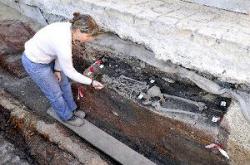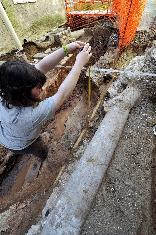- 15 AVRIL
- ESPAGNE – Torrox - Work being carried out in the area surrounding the Roman ruins in Torrox have uncovered remains of a temple dating back to the first century. Between 30 and 40 pieces, mainly lintels and fragments of columns have been found near the coast and work is ongoing in the hopes of discovering other hidden remains. The archaeologist supervising the works, Aurora Urdiales, has classified it as an “impressive discovery, both due to the magnitude and dimension of each element and due to the state of conservation in which they have been found”. The temple is believed to be part of the old Roman town of Caviclum, located in the area where the lighthouse can now be seen.
http://www.euroweeklynews.com/2011041486664/news/axarqu%C3%ADa-m%C3%A1laga-east/remains-of-ancient-roman-temple-uncovered.html
- FRANCE –  Bourbonnais - Les travaux de la déviation de la RN7 à Varennes-sur-Allier ont permis de mettre à jour des fragments de silex, des tessons de céramique et des outils pour le néolithique, des fosses de chasse de l'âge de bronze ou encore quelques-unes de ces fameuses petites figurines gallo-romaines en terre blanche, qui se sont exportées (et ont été copiées) dans toute l'Europe. Pour l'âge du fer, les archéologues ont dégagé des ateliers artisanaux de bracelets de schiste (noirs et lisses) à Buxières et Montcombroux-les-Mines, qui ont eux aussi connu un certain succès commercial. Et comme ils commencent à bien connaître leur terrain (dix ans de travaux) à Hérisson, sur le plateau de Chateloy, ils devraient s'essayer à reconstituer un morceau de rempart de la fin de l'époque gauloise, en blocs taillés. « Carnet de fouilles » aura également la primeur des premières découvertes effectuées sous le futur hypermarché E. Leclerc à Avermes : une nécropole gallo-romaine très bien conservée pourrait être bientôt fouillée. Des vases d'offrandes entiers ont déjà été sortis de terre. Pour le Moyen Âge, trois sites ont retenu l'attention des services du Conseil général : l'ancienne église de Molles, sur le site de la Couronne, l'église Saint-Blaise à Chareil-Cintrat et le prieuré de Montluçon. « Ces vestiges vont nous permettre d'expliquer la christianisation progressive et les rites funéraires ».
Bourbonnais - Les travaux de la déviation de la RN7 à Varennes-sur-Allier ont permis de mettre à jour des fragments de silex, des tessons de céramique et des outils pour le néolithique, des fosses de chasse de l'âge de bronze ou encore quelques-unes de ces fameuses petites figurines gallo-romaines en terre blanche, qui se sont exportées (et ont été copiées) dans toute l'Europe. Pour l'âge du fer, les archéologues ont dégagé des ateliers artisanaux de bracelets de schiste (noirs et lisses) à Buxières et Montcombroux-les-Mines, qui ont eux aussi connu un certain succès commercial. Et comme ils commencent à bien connaître leur terrain (dix ans de travaux) à Hérisson, sur le plateau de Chateloy, ils devraient s'essayer à reconstituer un morceau de rempart de la fin de l'époque gauloise, en blocs taillés. « Carnet de fouilles » aura également la primeur des premières découvertes effectuées sous le futur hypermarché E. Leclerc à Avermes : une nécropole gallo-romaine très bien conservée pourrait être bientôt fouillée. Des vases d'offrandes entiers ont déjà été sortis de terre. Pour le Moyen Âge, trois sites ont retenu l'attention des services du Conseil général : l'ancienne église de Molles, sur le site de la Couronne, l'église Saint-Blaise à Chareil-Cintrat et le prieuré de Montluçon. « Ces vestiges vont nous permettre d'expliquer la christianisation progressive et les rites funéraires ».
http://www.lamontagne.fr/editions_locales/moulins/sous_la_terre_l_histoire_du_bourbonnais@CARGNjFdJSsBEBgNBhk-.html
- ROYAUME-UNI – Stratford upon Avon - Archaeologists will be delving into layers of Tudor soil untouched for four hundred years as they resume the Dig for Shakespeare on the site of the playwright’s last home at New Place, Stratford-upon-Avon. The live archaeological project will explore foundations and other remains thought to date from Shakespeare’s era, which were uncovered shortly before the Dig was put under wraps for winter. The Dig for Shakespeare has already unearthed evidence which is challenging the historic interpretation of how Shakespeare’s house would have looked, and how the property was used. Paul Edmondson said, “The so-called ‘bay window’ identified by the antiquarian archaeologist Halliwell-Phillips in 1862 was thought to belong to the 18th century house at New Place. Halliwell stopped short when he reached the foundations, but we are now going deeper to excavate the underlying medieval features which could tell us much more about the house that Shakespeare bought and renovated, and how it related to Nash’s House next door, where his granddaughter lived .” Finds so far include roof tiles, pottery and animal remains which suggest that New Place was at times a high status household, with venison, and salt and fresh water fish supplementing the diet of meat from cows, pigs, sheep, geese and chickens. Shakespeare was a wealthy and famous man by the time of his death in 1616; his daughter Susanna is known to have entertained Queen Henrietta Maria, wife of King Charles, at New Place in 1643. New Place was also a hive of activity; features dating from 1500-1700 include a possible oven or kiln, a brick-built storage pit, and a possible quarry pit, together with evidence of bone working and lace making suggest that the site was used for a wide range of cottage industries and crafts for a long period.
http://www.anglotopia.net/anglophilia/archaeologists-dig-deeper-for-shakespeare%E2%80%99s-last-home-in-virgin-tudor-soil/
- FRANCE –


Sauvigny - Les archéologues qui travaillent actuellement dans trois artères du bourg, ont, par exemple, enterré l'idée qu'une voie romaine et\ou un cimetière pouvaient dormir sous la rue de la Verrerie : « Nous n'avons rien trouvé. S'il y avait une voie antique, nous verrions une épaisse couche de cailloux », confie Sophie Liegard, archéologue au service des fouilles préventives du Conseil général. Ni cailloux, ni tombes. Cela n'est pas le cas dans la rue du Chapeau-Rouge. Dans la tranchée, l'équipe est au chevet d'un squelette qui émerge ainsi du Moyen Âge : « On les date entre le IXe et le XIe siècles. Les cercueils, en bois, sont dans un état exceptionnel ». Dans cette rue, où les fouilles ne sont pas encore terminées, les archéologues ont découvert cinq tombes et cinq squelettes. Ce qui n'a rien de surprenant : « Nous avions déjà répertorié cent vingt tombes dans le secteur de l'église lors de fouilles précédentes. Nous savions que nous allions trouver d'autres cercueils rue du Chapeau-Rouge. Au Moyen Âge, on voulait être inhumé au plus près des lieux de culte et de reliques ».
http://www.lamontagne.fr/editions_locales/moulins/cinq_squelettes_decouverts_a_souvigny@CARGNjFdJSsBEBsHAhg-.html
- ROYAUME-UNI – Craigmillar - An old freezer is being investigated after being found dumped in the middle of Craigmillar. But the case is unlikely to trouble the city's fly-tipping patrols, as the discovery dates back hundreds of years. The 18th century ice house is just one of a series of new discoveries made by archaeologists at the Niddrie Marischal estate over the past few weeks ahead of flood prevention work in the area. Pottery has also been recovered from medieval ditches - dating back to the 15th century or possibly even earlier - and evidence of a 17th century farm has been uncovered. Niddrie Marischal House was built on the site around 1636 and was demolished in the 1960s, but it is believed the origins of the estate may go as far back as the 12th century. John Lawson, the council's curator of archaeology, said: “One of the things we have found was something we never knew existed, an early farmhouse. "We have found a very nice well associated with the farmhouse which may throw up some interesting artefacts." The remains of the farm include cobbled surfaces and hearth and stone foundations. A replacement farm was built around 1800 just to the east of these remains.The earliest form of freezer, ice houses were a common feature of large mansions throughout the UK in the late 18th and 19th centuries. The large chambers were dug into mounds and filled with ice or snow in the winter, and were used to preserve food and to keep wines cool in summer. It is hoped the ice house, a circular stone-lined pit, will be preserved on the site.
http://www.scotsman.com/news/Archaeologists-find-ancient-39freezer39-at.6752283.jp
- ROYAUME-UNI – Kincorth - Information on the early history of Kincorth Hill and the development of the urban area of Kincorth. Among the many archaeological sites on Kincorth Hill are a number of possible prehistoric locations; there are also quarries dating from the 19th and 20th centuries. Historically, the hill was the site where the Covenanters camped before the Battle of the Bridge of Dee in 1639; one of Aberdeen's serious defeats during the Civil War.
http://www.aberdeencity.gov.uk/CouncilNews/ci_cns/pr_kincorthtrail_150411.asp
- USA – Hinds Cave - Man’s best friend was actually man’s food source? This discouraging piece of information was shared at a recent Society for American Archaeology meeting in Sacramento. According to archaeologists’ findings, ancient canine bones dating back 9300 years were discovered at the Hinds Cave site in Texas. The bones, believed to be from the shoulder of a dog, were discovered in human fecal matter…the obvious implication – humans were not bringing dogs along for companionship, instead, the dogs were likely a food source. The archaeologists’ bone discovery was to that of the oldest genetically identified dog in the America’s. Prior bones dated back just 1500 years.
http://www.examiner.com/dogs-in-national/archaeology-findings-suggest-that-dogs-were-dinner-not-friends